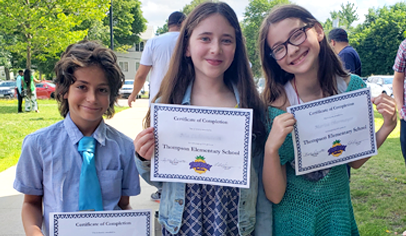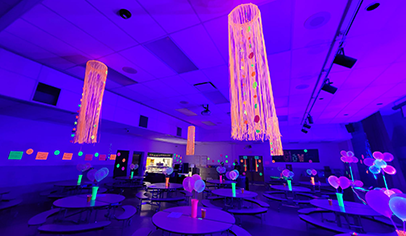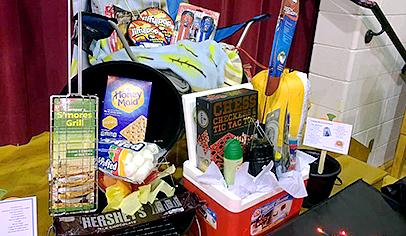Event: House Tour
Group: Capitol Hill Cluster School PTA
Location: Washington, D.C.
Amount Raised: $40,000
Notable: Sponsorships cover costs; ticket sales are all profit
If you're dying to see the inside of your neighbor's home on Capitol Hill in Washington, D.C., or need some inspiration for that remodeling you're planning, you're in luck each October. That's when the Capitol Hill Cluster School PTA sponsors one of its major annual fundraisers, the Renovator's House Tour, which opens eight to 10 historic homes to the public.
"Some people joke and call it the 'nosy neighbor's tour,' but it's really much more," says Robert Zakin, cochairman of the event with his wife, Shelley Smith, and a third parent, Libby Clarke. "Who doesn't want to roam through their neighbors' homes and see what they've done?" Smith adds.
From the looks of it, lots of people want to. Last year, the PTA sold 1,400 tickets and raised a record of almost $40,000. In the previous four years, the tour had raised an additional $80,000.
The idea was hatched five years ago by a group of parents who noticed how successful other local house tours were. The parents thought that their neighborhood, filled with attached row houses from the 19th and early 20th centuries and home of the nation's largest historic district, could easily support another tour.
Instead of focusing merely on the preservation of elegant homes, "the idea behind this tour was how do you make a 19th century home work for a modern family," Zakin explains. "The tour focuses on [renovations with] creativity and simplicity. We get people doing interesting things on a shoestring, as well as those who have a lot of money to spend." The goal is "to give people ideas and inspiration for things they can do in their own homes."
The tours have shown everything from complete gut renovations to the simple use of unusual colors, like lime green and strawberry pink, to liven up an interior. Last year, the tour featured a local landmark-the former residence of James W. Whelpley, assistant treasury secretary of the United States under President Grover Cleveland. The house is unusual for Capitol Hill in that it is a completely detached home. After years of serving as a multitenant dwelling with nine apartments, walls were torn down, and it was brought back to its original 1876 glory as home for a local family with four sons.
Organizing the Tour
Work on last October's tour began seven months earlier, when Smith, a public health adviser, and Zakin, a documentary filmmaker, met with the former chairpeople to get briefed. (The couple has three children. Each attends one of the three campuses that make up the Cluster School. The school serves grades preK-8.)
Over the summer, they began identifying homes to include on the tour, a process that involved asking local realtors, contractors, and architects for suggestions, as well as talking to new homeowners or neighbors who have done renovations. While some people contact them directly and offer to participate, others need "a little cajoling" to open their homes to more than a thousand visitors, says Smith.
In addition to finding the homes, a key component is recruiting sponsors, who pay for all expenses. For $750, a business can sponsor a home. In return, the business receives advertising on the event website (www.renovatorshousetour.org), plus a sign with the business name posted in the front yard. Other contributors, including local painters, decorators, hardware stores, and interior designers, pay $100 to have their contact information listed in the tour booklet. This year, the group raised $13,000 in sponsorships, which more than covered all expenses. That meant all ticket revenue could benefit the school and PTA.
Smith believes that publicity is another major factor in the tour's success. "You can't just create a good idea and expect people to show up," she says. "You have to create a whole buzz around it." She, Zakin, Clarke, and other volunteers talked up the tour in the playground, at back-to-school nights, and at PTA meetings. They advertised in local newspapers, hung posters, sent letters to parents, and promoted the event on their website. After all, she notes, the tour isn't just an important fundraiser: "It raises awareness of our school in the larger community." The event is a huge coordination of manpower, Zakin explains. More than 150 volunteers were involved last year. In addition to all the planning and organizing, dozens of docents (including parents, teachers, and even the school's principal) are trained to answer questions and give information about the homes during shifts on the day of the tour. "You're only as good as your volunteers, and we have really dedicated parents, teachers, and administrators," he says.
Even with all the hours involved in chairing the event together—in addition to their day jobs and raising three children—Smith and Zakin, along with Clarke, have volunteered again. They're already thinking of ideas for this year's tour, scheduled for Oct. 14.
The one thing they decided against was putting their own house—a renovated 1885 three-story Victorian, four blocks from the Library of Congress—on the tour. "That," says Smith, "would have just been too crazy. We have a long list of things we want to do [to the house] first. But we'll eventually be on the tour. What a great cause to open up your doors for."
And their neighbors no doubt will be lining up to get a peek inside.
How the Capitol Hill Cluster School PTA Builds a Profit
- Get school administrators and teachers involved in your fundraiser. They'll help spread the word, and their involvement connects the school with the community.
- Encourage the chairs of such a major fundraiser to volunteer for two consecutive years and to help train the incoming group for a smooth transition.
- Put information on the planning details, finances, timeline, and contacts in writing. This can be passed along each year, and the wheel won't have to be continuously reinvented.
- Recruit local businesses to get involved and become sponsors; they get good publicity, and you get expenses covered.
- Have a theme—try a garden tour or one for kitchens and baths. Ask local architects, decorators, or landscapers to be available in the homes to talk about their work.
- In the suburbs, where homes are not always within walking distance, showcase homes within a short driving distance of each other and provide a map showing the route.
- Once a homeowner agrees to participate, treat her like royalty; without her, there is no tour, Smith says. Give her a welcome basket and an end-of-tour appreciation gift.
- Create buzz. Spread the word to local newspapers, advertise, hang posters, and get parents involved by selling tickets and telling friends, relatives, and coworkers. Offer families a prize for selling the most tickets.
- Set up some stops along the route to give visitors time to rest and talk, such as a lemonade stand manned by students or wine and cheese at a local store or restaurant.
- Tap your parent body for their pro bono professional expertise in public relations, graphics, and web design. Also recruit volunteers willing to head up specific tasks and let them recruit their own team of volunteers.
- Cross your fingers for good weather. Smith says high sales last year were due in large part to the beautiful weather on the day of the tour. "We were very lucky," she says.























